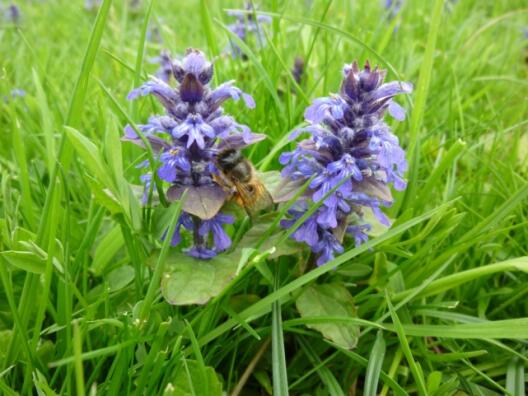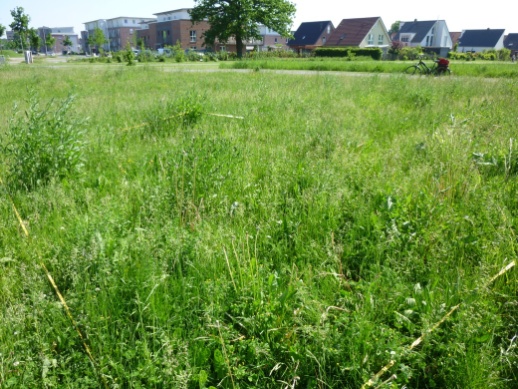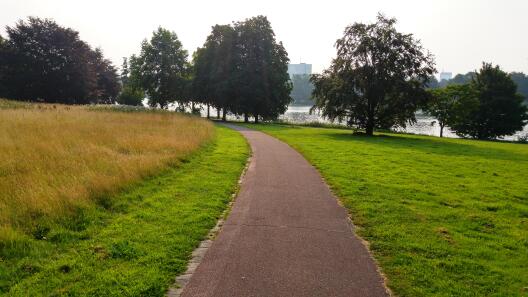Background and Aim

Flowering plants are similarly attractive to humans and bees.© Frederike Velbert Towns and municipalities maintain a large number of public green spaces. Although most of them are managed at low intensity, as it is done in endangered, semi-natural and species-rich grasslands with only one or two cuts a year without applications of fertilizers or pesticides, urban grassland vegetation is usually species-poor and floristically unappealing. Furthermore, these stands often contain high numbers of cultivars but only few native or regionally adapted plant species. Due to dispersal limitation and missing source populations of target grassland species, urban grasslands often remain species-poor for a quite long time. Consequently, their value for nature conservation but also for the city population is strongly restricted as long as no interventions such as floristic enrichment are done.
To optimize green areas as habitats for the local species pool, it is important to analyses underlying factors and mechanisms determining species diversity in urban grasslands. Based on this knowledge, the introduction of plant species can be suggested to develop and appreciate urban grasslands and to simultaneously create high-quality, flower-rich green spaces for the city population. Today, the ecological potential of urban green spaces for nature conservation and the benefit for socio-economics is often widely underestimated.
This research project aims at identifying and assessing the above addressed potentials of urban grasslands in order to make recommendations for ecological optimizations. Furthermore, the project also involves a questionnaire study to include the ideas and expectations of the city population into this process.

A study plot in a suburb of Münster.© Frederike Velbert Methods
During the last years, intensive research has been done in urban green spaces and grasslands in several cities within the federal state of North Rhine-Westphalia. Among these are Münster, Osnabruck, Düsseldorf and Cologne. Besides floristic surveys, soil and plant biomass samplings have been done to assess site fertility and the trophic status of the grasslands. In 2014, we also started a small species-introduction project in park grasslands in Münster. Here, we used regionally produced seeds of native species and small-scale sward disturbance to (re-)introduce plant species into grasslands at the lake Aasee. A further study was done on the connectivity of public urban grasslands in Münster, focusing on the ability of plant species to disperse among already realized habitat patches. Since 2015, we also started surveys inquiring the city population about their feelings and opinions regarding urban grasslands and evaluating their willingness to accept a more near-natural management. This questionnaire study was first performed in Münster only, but since 2016, based on a large-scale cooperation, the same study is also done in several cities across Europe.

Near-natural management (left side) and multi-cut lawns (right) in urban grasslands at the lake Aasee in Münster.© Valentin H. Klaus We thank all city councils for the fertile cooperation as well as all involved people for their motivation and enthusiasms.
Research
Publications (peer-reviewed)
Hejkal J, Buttschardt TK, Klaus VH (2017) Connectivity of public urban grasslands: implications for grassland conservation and restoration in cities. Urban Ecosystems 20 (2): 511-519 [doi: 10.1007/s11252-016-0611-8]
Rudolph M, Velbert F, Schwenzfeier S, Kleinebecker T, Klaus VH (2017) Patterns and potentials of plant species richness in high- and low-maintenance urban grasslands. Applied Vegetation Science 20 (1): 18–27 [doi: 10.1111/avsc.12267]
Klaus VH (2013) Urban grassland restoration: a neglected opportunity for biodiversity conservation. Restoration Ecology 21: 665–669 [doi: 10.1111/rec.12051]
Finished theses and projects
Sollentsch, Lisa (2016) Urban und park grasslands in Osnabrück, Germany. Bachelor Thesis
Auerochs, Hannah (2015) Biodiversity of urban grasslands – a questionnaire in the City of Münster, Germany. Bachelor Thesis
Rudolph, Martin (2015) Current and Potential Plant Species Richness in Urban Grasslands. Master Thesis
Eckardt, Melanie (2015) Projects on urban grassland restoration in Germany - An overview. Bachelor Thesis
Hejkal, Judit (2014) Connectivity of urban hatitats. Master Thesis
Schreiter, Maria (2014) Plant diversity in urban grasslands of Dortmund. Master Thesis
Stahlhut, Nils (2014) Experiment on floristic enrichment in urban grasslands with with regionally produced seed mixtures. Bachelor Thesis
Schwenzfeier, Stefan (2013) Plant diversity in multiple-cut grasslands in Münster. Bachelor Thesis
Velbert, Frederike (2013) Current and Potential Plant Species Richness in Urban Grasslands. Students Research Projects - M.Sc.


